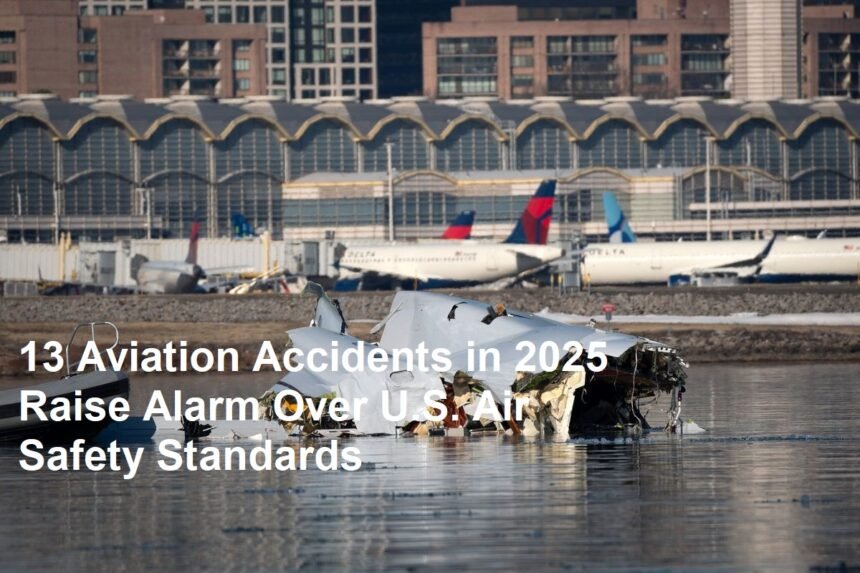Washington, D.C. – A troubling surge in aviation accidents has plagued the United States throughout 2025, with 13 separate incidents involving commercial planes, private aircraft, and helicopters recorded as of December. These tragedies, resulting in 47 fatalities and over 100 injuries, have ignited urgent calls for regulatory overhauls and renewed scrutiny of maintenance protocols, pilot training, and emerging technologies in the aviation sector.
Chronology of Key Incidents
The year began grimly on January 8, when a chartered helicopter carrying four executives crashed into a Miami high-rise during a thunderstorm, killing all aboard. Investigators later cited pilot disorientation in heavy rain as a probable cause. In March, a mid-air collision between a sightseeing helicopter and a small Cessna plane near the Grand Canyon left six dead, exposing flaws in air traffic control coordination over national parks.
May saw two high-profile crashes: a vintage Boeing 737 operated by a regional airline lost engine power and crash-landed in a Texas field, injuring 12, while a medical helicopter in Chicago collided with a drone during an emergency flight, narrowly avoiding fatalities. The summer months brought further chaos, including a runway overrun by a cargo plane in Denver that destroyed critical navigation equipment and a private jet crash in Aspen linked to fuel contamination.
Investigative Findings and Common Threads
Preliminary reports from the National Transportation Safety Board (NTSB) reveal recurring issues: four accidents involved mechanical failures tied to aging aircraft components, three were attributed to pilot error during extreme weather, and two stemmed from air traffic control miscommunications. The remaining cases, including the drone collision, point to risks posed by unregulated technologies.
“The frequency of these incidents is unprecedented in recent decades,” said NTSB Chair Jennifer Homendy. “While each case is unique, systemic gaps in maintenance oversight and inconsistent training standards are clear contributors.”
Regulatory and Industry Response
In July, the Federal Aviation Administration (FAA) launched an emergency audit of 25 regional airlines and helicopter operators, grounding 12 aircraft for safety violations. The agency also fast-tracked mandates for collision-avoidance systems in helicopters and stricter drone no-fly zones near airports.
Major carriers like American and United announced plans to retire older planes ahead of schedule, while pilot unions demanded enhanced simulator training for severe weather scenarios. “The industry is at a crossroads,” said Capt. Dennis Tajer of the Allied Pilots Association. “We’re flying more complex aircraft in busier skies with outdated protocols.”
Public Outcry and Legislative Action
Relatives of victims have mobilized, forming advocacy groups such as Safe Skies 2025 to lobby Congress. Their efforts spurred the introduction of the Aviation Safety Modernization Act in September, proposing $2 billion in funding for infrastructure upgrades and penalties for lax maintenance practices.
However, the bill faces opposition from budget-conscious lawmakers and private aviation lobbyists. “Safety cannot be compromised, but we must balance innovation with practicality,” argued Rep. Sam Graves (R-MO), a pilot and House Transportation Committee member.
Technological Challenges and Future Risks
The rise of drone delivery services and electric vertical takeoff (eVTOL) taxis has further complicated airspace management. In October, a near-miss between an eVTOL prototype and a passenger jet near Los Angeles International Airport underscored the regulatory lag. “Integration of new tech is outpacing safety frameworks,” warned FAA Deputy Administrator Bradley Mims.
Meanwhile, cybersecurity experts flagged vulnerabilities in plane navigation systems after a hacker group claimed responsibility for tampering with a cargo plane’s GPS in November. While the FAA denied the breach, the incident amplified fears of digital threats.
Global Context and Comparisons
While the U.S. grapples with its safety crisis, global aviation data shows a contrasting trend: the International Air Transport Association (IATA) reported a 9% drop in accidents worldwide in 2025, attributed to enhanced safety measures in Asia and Europe. Analysts suggest the U.S., once a leader in aviation safety, is now struggling to adapt to 21st-century challenges.
Victim Impact and Memorials
Among the mourners is Lisa Nguyen, whose brother died in the Grand Canyon collision. “He proposed to his fiancée there a year earlier,” she shared at a D.C. vigil. “These accidents aren’t statistics—they’re families shattered.” Memorials now dot accident sites, from Colorado mountainsides to Miami skyscrapers, serving as somber reminders of the human toll.
As 2025 draws to a close, the FAA pledges to implement a “zero-accident vision” by 2030, leveraging AI for predictive maintenance and real-time airspace monitoring. Yet, for grieving families and wary travelers, trust remains fragile.
“We’re racing to correct decades of complacency,” acknowledged FAA Administrator Mike Whitaker. “Every accident is a lesson, but the cost of these lessons is unbearably high.” With air travel demand projected to double by 2040, the urgency to rebuild America’s aviation safety legacy has never been greater.












